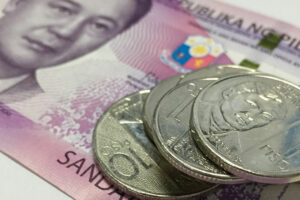




Philippines Trade Update: Exports momentum continues
 DOWNLOAD
DOWNLOAD

Quarterly Economic Growth Release: More BSP cuts to come
 DOWNLOAD
DOWNLOAD

Monthly Economic Update: Fed catches up
 DOWNLOAD
DOWNLOAD


Reserve ratio cut may have little effect

The cut in Philippine banks’ reserve requirement ratio (RRR) would have minimal effect on liquidity because these would only replace an expiring relief measure given to lenders amid a coronavirus pandemic, analysts said at the weekend.
“The reserve requirement cut is expected to be liquidity-neutral because it offsets pandemic-era relief measures,” Nicholas Antonio T. Mapa, senior economist at ING Bank N.V. Manila, said in a Viber message.
“Any excess created can also be absorbed via the new Bangko Sentral ng Pilipinas (BSP) bill tenor. Thus, we are not expecting any adverse reaction to the move,” he added.
Last week, central bank Governor Felipe M. Medalla said the Monetary Board had cut the reserve ratio for big banks and nonbank financial institutions with quasi-banking functions by 250 basis points (bps) to 9.5% effective June 30.
The ratio for digital banks was also cut by 200 bps to 6%, and by 100 bps to 2% for thrift banks. The reserve ratio for rural and cooperative banks was likewise lowered by 100 bps to 1%.
The cuts will coincide with the expiration of a pandemic relief measure that counts loans to micro, small and medium enterprises (MSME) as an alternative compliance with reserve requirements.
“Although the RRR in the Philippines will still be the highest in the Association of Southeast Asian Nations (ASEAN), it is still a big benefit to banks as the level came from the heights of 20% in 2018,” Aris Dacanay, an economist for ASEAN at HSBC, said in a note.
He added that the expiration of alternative compliance for big banks is estimated to mop up PHP 272.4 billion (USD 4.9 billion) worth of liquidity, while the 250-bp cut in the RRR will likely release PHP 360.1 billion of liquidity.
“Taken all together, we estimate the net effect to be P87.7 billion,” he said. “This will be a net injection of liquidity in the system, but a limited one, given that it represents just 6.3% of the excess liquidity currently being absorbed by the BSP.”
He noted that when the reserve ratio cut takes effect, the BSP will be issuing its 56-day bill. “The liquidity injected by the RRR cut will likely be absorbed by this new tool on that same day,” Mr. Dacanay said.
While the cut will free up more money for banks to lend to consumers, it will have a small effect on the foreign exchange market, Robert Dan J. Roces, chief economist and assistant vice-president at Security Bank Corp., said in a Viber message.
“The Philippine forex market is currently in a state of flux,” he said. “The direction of the peso will likely depend on the outcome of a number of factors, including the strength of the dollar, the performance of the Philippine economy, trade levels and stability in interest rates.”
The peso has weakened against the dollar in the past months amid the US Federal Reserve’s mixed signals on its future policy moves and talks about the US debt ceiling, he said. “The speculative nature of the policy directions will lend to volatility in the dollar-peso exchange rate.”
Last month, the Monetary Board paused its policy tightening and signaled it would keep the key rate on hold until the third quarter. The BSP has raised policy rates by 425 bps to 6.25%.
On the other hand, the Federal Open Market Committee delivered a 25-bp rate increase last month, bringing the Fed fund rate to 5-5.25%. The Fed, which has hiked borrowing costs by 500 bps, will meet on June 13-14.
Well-telegraphed
The impact of China’s economic slowdown on Philippine exports could also widen the trade gap, putting more pressure on the peso, Mr. Roces said. “June is traditionally import season and as such, we will continue to see fluctuations in the exchange rate.”
The local currency closed at P56.05 a dollar on Friday, strengthening by six centavos from Thursday, data from the Bankers Association of the Philippines website showed. Week on week, the peso declined by 16 centavos.
Meanwhile, the central bank would be more effective in carrying out the reserve ratio cut than in 2018, when the market reacted negatively to a surprise reduction that was accompanied by rate increases, Mr. Mapa said.
He added that the cut had been well-telegraphed and well-executed, while the BSP has tools now to absorb any excess liquidity — something that was absent in 2018.
Since March 2018, the BSP has been targeting to reduce big banks’ reserve requirement ratio to below 10%.
Mr. Dacanay said the timing of the cut is crucial. If the relief measures were not expiring, the cut could be interpreted as a “dovish signal” at a time when inflation is still elevated.
DBS Bank economist Chua Han Teng said in a note the cut does not imply a shift in the BSP’s monetary policy stance.
As inflation returns to the central bank’s 2-4% target by the fourth quarter, “we think that policy makers can wait and see for now,” he said.
Inflation eased for a fourth straight month in May to 6.1% — the lowest in a year. Still, it surpassed the central bank’s 2-4% goal for the 14th straight month. To date, inflation has averaged 7.5%.
The Monetary Board will meet on June 22 to review its policy settings. — Keisha B. Ta-asan, Reporter
This article originally appeared on bworldonline.com





 By BusinessWorld
By BusinessWorld